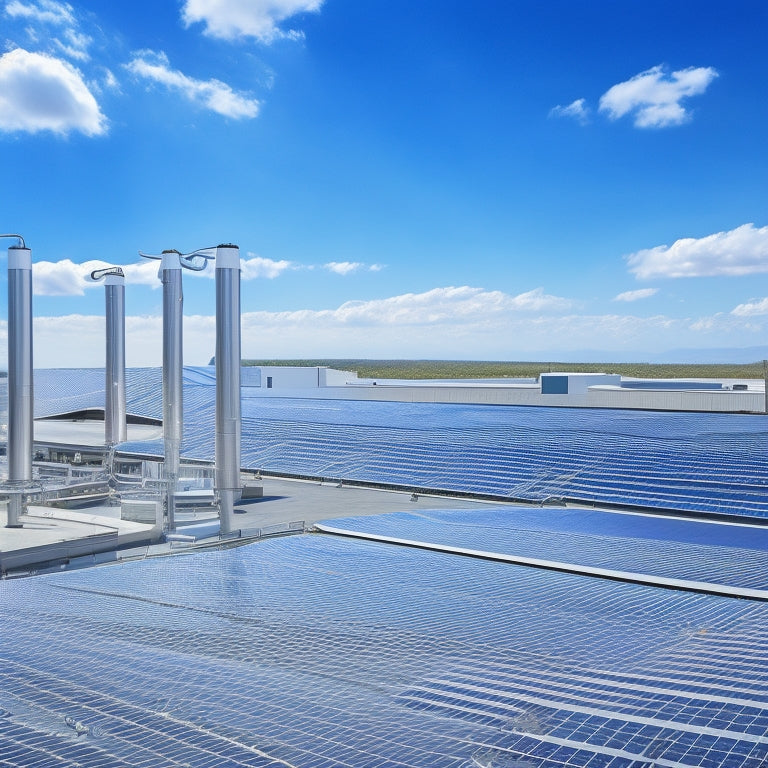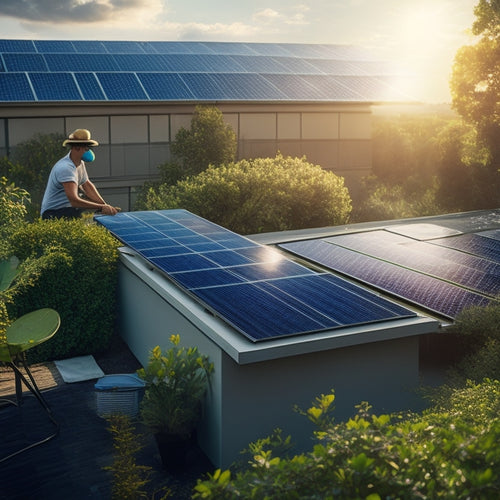
How to Design a Solar System for Commercial Buildings
Share
When designing a solar system for your commercial building, you'll need to assess your energy needs by analyzing historical usage patterns and identifying opportunities for energy efficiency upgrades. Evaluate your roof's structural integrity and assess its orientation to maximize energy production. Select suitable solar panels, inverters, and mounting systems based on your energy goals and operational needs. Verify your system design complies with local building codes and integrates seamlessly with your existing electrical infrastructure. By following these steps, you'll be well on your way to creating a customized solar system that meets your building's unique energy requirements - and that's just the beginning.
Key Takeaways
- Assess energy needs and system size through energy demand analysis, system capacity calculation, and financial analysis to ensure accurate load assessment and cost savings.
- Evaluate roof space and structural integrity by assessing roof orientation, structural integrity, and compliance with local building regulations.
- Select suitable solar components, including solar panels, inverters, and mounting systems, based on efficiency, cost, warranty, and sustainability factors.
- Design an optimal system layout and panel placement strategy based on electrical load assessment, solar orientation, and shading analysis to maximize energy production.
- Ensure compliance and integration by meeting local building codes, integrating with existing electrical systems, and planning for energy metering, monitoring, and storage solutions.
Assessing Building Energy Needs
When designing a solar system for a commercial building, understanding the building's energy needs is vital. You must assess the building's current energy usage patterns, including peak demand periods and overall energy consumption. This analysis will help you determine the best system size and configuration to maximize energy efficiency and reduce operational costs.
You should also consider the building's demand response capabilities, as well as any renewable incentives or utility partnerships that can benefit your project. Aligning your solar system with the building's sustainability goals will guarantee a strong business case and potential financial incentives.
A thorough financial analysis will help you evaluate the system's return on investment and identify opportunities for cost savings. Additionally, maintenance planning and system scalability must be considered to guarantee the system's long-term performance and ability to adapt to changing energy needs.
Evaluating Roof Space and Condition
With a clear understanding of the building's energy needs, you can now shift your focus to the roof, which will host the solar system. Evaluating the roof space and condition is vital to guarantee a successful installation.
First, assess the roof orientation, as it affects the system's energy production. A south-facing roof is ideal, but you can still achieve peak performance with east- or west-facing roofs.
Next, inspect the roof's structural integrity to determine if it can support the weight of the solar panels. Conduct a shading analysis to identify any obstacles that may block sunlight, such as skylights, vents, or nearby buildings.
Consider weather conditions, including wind, snow, and hail loads, to select suitable mounting hardware. Confirm maintenance access is easy and safe, and plan installation logistics to minimize disruptions to the building's operations.
Verify compliance with local building regulations and consider the aesthetic impact of the solar system on the building's appearance. By carefully evaluating these factors, you can design a solar system that meets the building's energy needs while guaranteeing a safe and efficient installation.
Choosing the Right Solar Panels
Your solar system's performance hinges on the quality and suitability of the solar panels you choose. You need to take into account several factors to guarantee you select the right ones for your commercial building.
When evaluating solar panels, you'll encounter different types, including monocrystalline, polycrystalline, and thin-film. Each type has its own efficiency ratings, installation costs, and warranty options. Here's a comparison of some popular solar panel brands:
| Brand | Efficiency Rating | Installation Cost | Warranty |
|---|---|---|---|
| Tesla | 20.6% | $2.85/W | 25-year performance guarantee |
| Panasonic | 21.8% | $3.15/W | 25-year warranty |
| Trina | 20.3% | $2.50/W | 25-year warranty |
| SunPower | 22.8% | $3.50/W | 25-year warranty |
When selecting solar panels, bear in mind sustainability factors, maintenance requirements, and aesthetic considerations. For instance, some panels may have a higher environmental impact due to manufacturing processes. Additionally, some panels may require more frequent cleaning, which can increase maintenance costs. Finally, take into account the visual appeal of the panels and how they'll integrate with your building's design. By assessing these factors, you'll choose the right solar panels for your commercial building.
Selecting Inverters and Mounting Systems
Opt for high-quality inverters and mounting systems to guarantee your solar system operates efficiently and safely.
These components play an essential role in converting DC power from your solar panels to AC power for your commercial building.
When selecting inverters, consider the following key factors:
-
Inverter types: Choose from string inverters, microinverters, or power optimizers based on your system's design and performance requirements.
-
Mounting materials: Select durable and corrosion-resistant materials that can withstand environmental conditions, such as aluminum or stainless steel.
-
Installation techniques: Ascertain proper installation to minimize energy losses and maximize system efficiency.
- Performance monitoring and warranty considerations: Look for inverters with built-in monitoring capabilities and strong warranties that cover maintenance and repairs.
Designing a Safe and Efficient Layout
When designing a safe and efficient solar system layout for your commercial building, you'll need to conduct an electrical load assessment to determine the system's power requirements.
This assessment will inform your panel placement strategy, guaranteeing that the system operates within safe voltage and current limits.
Electrical Load Assessment
An electrical load assessment is essential in designing a safe and efficient solar system for commercial buildings, as it determines the total power requirements of the facility. This assessment helps you understand the energy usage patterns of your building, ensuring that your solar system can meet the demand.
You'll need to analyze your energy bills, occupancy schedules, and equipment usage to get an accurate representation of your energy needs.
To conduct a thorough electrical load assessment, consider the following:
-
Historical energy usage: Review your past energy bills to identify peak usage periods and overall energy consumption.
-
Load forecasting: Use historical data to predict future energy demands, considering factors like weather patterns and occupancy rates.
-
Energy efficiency opportunities: Identify areas where energy-efficient upgrades can be made, such as installing LED lighting or energy-efficient HVAC systems.
- Building occupancy and usage: Understand how the building is used, including the number of occupants, operating hours, and equipment usage.
Panel Placement Strategy
Your solar panel placement strategy is fundamental in designing a safe and efficient layout for your commercial building's solar system. When selecting a placement strategy, consider the solar orientation of your building to maximize energy production. A shading analysis will help identify areas that receive the most sunlight, guaranteeing ideal panel placement.
Durability is also vital, as panels must withstand various weather conditions. Aesthetic considerations, such as panel color and mounting style, can be addressed while maintaining efficiency. Ascertain maintenance access is easy and safe, reducing downtime and repair costs.
Weather impact, including wind, snow, and hail, must be factored into your design. Installation logistics, such as roof size and structural integrity, will influence your placement strategy. Finally, consider the grid connection and how it will affect your system's overall performance.
Sizing the Solar System Correctly
When sizing a solar system for your commercial building, you'll need to assess the energy demands of your facility to determine the required system capacity.
This involves analyzing your building's historical energy usage patterns, as well as its peak demand periods.
Assessing Energy Demands
To guarantee a solar system meets a commercial building's energy needs, you must accurately assess its energy demands. This involves analyzing various factors that impact energy consumption trends.
-
Peak usage analysis: Identify the building's peak energy usage periods to determine the required system capacity.
-
Building orientation impact: Consider how the building's orientation affects energy consumption, as this can influence the system's design and placement.
-
Utility rate structures and demand response programs: Understand the utility rate structures and demand response programs to optimize energy usage and reduce costs.
- Sustainability goals alignment and future energy demands: Align the solar system design with the building's sustainability goals and future energy demands, taking into consideration potential energy efficiency upgrades and changes in building occupancy patterns.
Calculating System Capacity
Accurate calculation of system capacity is essential to guarantee the solar system meets the commercial building's energy demands without oversizing or undersizing the system. You must consider various factors, including the building's energy usage patterns, local solar irradiance, and available roof space.
A thorough energy audit will help you determine the required system capacity. You'll also need to assess the building's energy efficiency and potential for energy-saving measures to optimize the solar system's performance.
When calculating system capacity, you should also consider the impact of solar incentives, financing options, and tax credits on your project's viability. Confirm that your system design complies with regulatory requirements and is compatible with the grid connection.
Additionally, think about maintenance strategies and system warranties to confirm long-term reliability. By accurately sizing your solar system, you'll maximize the environmental impact of your renewable energy investment while minimizing costs.
Meeting Local Building Codes
You're about to start an exciting escapade of designing a solar system for your commercial building, but first, you need to guarantee that your system complies with local building codes.
This is an essential step that can't be overlooked, as failure to comply can result in costly rework, fines, or even project cancellation.
To ascertain compliance, consider the following key factors:
-
Local Regulations: Familiarize yourself with local ordinances, zoning laws, and building codes that govern solar installations in your area.
-
Compliance Strategies: Develop a plan to address specific code requirements, such as structural integrity, electrical safety, and fire resistance.
-
Permit Processes: Identify the necessary permits and approvals required for your project, and factor in the time and cost associated with obtaining them.
- Zoning Requirements: Verify that your solar system design meets local zoning ordinances, including setbacks, height restrictions, and aesthetic guidelines.
Ensuring Energy Metering and Monitoring
When designing a solar system for commercial buildings, you'll need to guarantee accurate energy metering and monitoring to track your energy usage effectively.
This involves installing meters that provide real-time performance data, enabling you to identify areas of inefficiency and optimize your system's operation.
Energy Usage Tracking
To guarantee a commercial building's solar system operates efficiently, its energy usage must be closely tracked.
You'll need to monitor energy consumption trends to identify areas of improvement and optimize your system's performance. This involves conducting usage pattern analysis to pinpoint periods of high energy demand and implementing demand response strategies to manage peak loads.
To achieve this, consider the following key aspects:
-
Efficiency benchmarks: Establish baseline energy consumption levels to measure the effectiveness of your solar system and identify opportunities for improvement.
-
Utility rate considerations: Analyze your utility rates to determine the most cost-effective times to draw energy from the grid or your solar system.
-
Occupancy impact assessment: Evaluate how occupancy patterns affect energy consumption and adjust your system's performance accordingly.
- Equipment energy profiles: Create detailed energy usage profiles for each piece of equipment to identify energy-intensive devices and optimize their operation.
Real-time Performance Data
By optimizing energy usage patterns, you've laid the groundwork for a high-performing solar system. Now, it's crucial to verify you have real-time performance data to monitor and analyze your system's energy production and consumption. This data will enable you to identify areas of improvement, optimize energy usage, and maximize your return on investment.
To achieve this, you'll need to install energy meters and monitoring systems that provide real-time data on energy production, consumption, and storage. This data can be used to generate performance analytics, helping you identify trends, patterns, and anomalies.
| Parameter | Monitoring Frequency |
| Energy Production | Real-time (every 1-5 minutes) |
| Energy Consumption | Real-time (every 1-5 minutes) |
| Energy Storage | Real-time (every 1-5 minutes) |
| System Performance | Hourly, daily, and monthly summaries |
With real-time monitoring and performance analytics, you'll be able to make data-driven decisions to optimize your solar system's performance, reduce energy waste, and increase your bottom line.
Planning for Energy Storage Options
As commercial buildings increasingly rely on solar power, integrating energy storage options becomes essential to secure a stable and efficient energy supply.
You'll need to plan for energy storage to guarantee that your building's energy needs are met during periods of high demand or when the sun isn't shining.
When planning for energy storage, consider the following key factors:
-
Battery Technologies: Choose the right battery technology that suits your building's energy needs, such as lithium-ion, lead-acid, or flow batteries.
-
Storage Economics: Calculate the cost-benefit analysis of energy storage, considering factors like peak shaving, load shifting, and grid independence.
-
System Scalability: Design a system that can scale up or down to meet changing energy demands, securing flexibility and adaptability.
- Backup Solutions: Integrate backup solutions, such as generators or diesel gensets, to provide reliable power during extended grid outages or maintenance.
Integrating With Existing Electrical Systems
When integrating solar power into your commercial building's electrical system, it's critical to guarantee seamless coordination between the new solar system and existing electrical infrastructure. This integration guarantees that your building's electrical system operates efficiently and safely.
You'll need to assess your building's grid connectivity and system redundancy to determine the ideal integration strategy. Effective energy management is essential, so you'll need to develop maintenance strategies to guarantee your system operates at peak performance.
Be sure to investigate available financial incentives, such as tax credits or rebates, to offset the cost of your solar system. Regulatory compliance is also necessary, so confirm your system meets all relevant building codes and standards.
Plan your installation timeline carefully to minimize disruptions to your business operations. Finally, insist on performance guarantees from your solar system provider to confirm your system meets its promised energy output.
Frequently Asked Questions
Can Solar Panels Be Installed on Walls Instead of Roofs?
You can opt for vertical installations, where wall-mounted panels are securely fastened to your building's exterior, providing an alternative to traditional rooftop installations, but guarantee you assess structural integrity and local building codes before proceeding.
How Do I Handle Shading From Surrounding Trees or Buildings?
When evaluating shading from surrounding trees or buildings, you'll conduct a shading analysis to identify obstruction periods and intensity. Consider tree trimming or pruning to minimize shading, and adjust your solar panel placement to optimize energy harvesting.
Are There Any Government Incentives for Commercial Solar Systems?
You'll benefit from government incentives for commercial solar systems, including federal tax credits of up to 30% of the total cost, and state-specific rebates, encouraging the adoption of renewable energy sources to power your business.
Can I Use Solar Power to Charge Electric Vehicle Fleets?
You can utilize solar power to charge electric vehicle fleets by integrating battery storage, optimizing charging infrastructure, and streamlining fleet management, ensuring energy efficiency while conducting a thorough cost analysis to maximize returns on your solar investment.
How Often Should I Clean and Maintain My Solar System?
As you bask in the glow of your solar system's productivity, don't let dust and dirt dim its sparkle. You should clean your solar panels every 6-12 months and stick to a strict maintenance schedule to guarantee peak energy harvesting and prolong its lifespan.
Conclusion
As you've steered through the complexities of designing a solar system for your commercial building, remember that each component is like a thread in a fabric. Weave them together thoughtfully, and you'll create a work of art of efficiency and sustainability. Just as a skilled pilot charts a course through uncharted waters, you've charted a path to utilize the power of the sun, illuminating your building's future with clean energy. Now, set sail into a brighter tomorrow!
Related Posts
-

Evaluating Solar Power Options for Businesses
Evaluating solar power options for your business can greatly reduce energy costs and enhance sustainability. Start by...
-

Green Ways to Maintain Solar Panels
To maintain your solar panels sustainably, start with regular inspections to catch potential issues early, enhancing ...
-

Integrating Smart Technology for Energy Savings
Integrating smart technology into your home is a transformative factor for energy savings. Smart thermostats give you...


